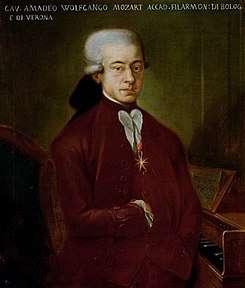Piano Concerto No. 5 (Mozart)
Piano Concerto No. 5 in D major, K. 175, was composed by Wolfgang Amadeus Mozart in 1773, at the age of 17. It is Mozart's first original piano concerto; his previous efforts were based on works by other composers.In 1782 he revised the score and composed a new rondo ( adding a flute to the instrumentation. ( K382 )
| Piano Concerto in D major | |
|---|---|
| No. 5 | |
| by W. A. Mozart | |
 The young composer, a 1777 copy of a lost painting | |
| Key | D major |
| Catalogue | K. 175 |
| Composed | 1773 |
| Movements | Three (Allegro, Andante ma un poco adagio, Allegro) |
| Scoring |
|
Instrumentation
The work is scored for 2 oboes, 2 horns, 2 trumpets, timpani, and strings and was the only concerto with trumpets and timpani until No. 10, K. 365. The second movement omits the trumpets and timpani.
Movements
The three movements of the concerto are listed as follows:
This concerto was a favorite of Mozart's and is mentioned in many of his letters.[1] He played the piece at concerts until his death.
Notes
- Hutchings (see references), p. 49-50.
gollark: `stack new`'s template does...
gollark: That's admittedly a little longer, but the `main :: IO ()` bit is optional.
gollark: ```haskellmain :: IO ()main = putStrLn "facebook"```
gollark: No.
gollark: Terse and expressive, really.
References
- Hutchings, A. 1997. A Companion to Mozart's Piano Concertos, Oxford University Press. ISBN 0-19-816708-3
External links
- Concerto in D KV 175: Score and critical report (in German) in the Neue Mozart-Ausgabe
- Piano Concerto No. 5: Scores at the International Music Score Library Project (IMSLP)
This article is issued from Wikipedia. The text is licensed under Creative Commons - Attribution - Sharealike. Additional terms may apply for the media files.